Recent Research Progress in Hybrid Photovoltaic–Regenerative Hydrogen Fuel Cell Microgrid Systems
Abstract
:1. Introduction
2. Integration of Components in Hybrid PV-RHFC Microgrid Systems
2.1. PV Modules
2.2. Electrolyzer and Fuel Cell Stacks
2.3. Energy Storage Units
2.3.1. Batteries
2.3.2. Hydrogen Storage
2.4. Power Electronics
2.5. Controllers
3. Development, Operation, and Control of Hybrid PV-RHFC Microgrid Systems
3.1. Modeling and Optimization Methods
3.2. Application of Control Strategies
4. Applications of Hybrid PV-RHFC Microgrid Systems
4.1. Nanogrid Systems
4.2. Multipurpose Microgrid Systems
4.3. Integration with Other Power Generating and Energy Storage Technologies
5. Critical Analysis and Discussion of Hybrid PV-RHFC Microgrid Systems
6. Future Prospects, Challenges, and Key Directions for Future Research
7. Conclusions
Author Contributions
Funding
Data Availability Statement
Acknowledgments
Conflicts of Interest
Abbreviations
| AC | Alternating Current |
| AEC | Alkaline Electrolyzer Cell |
| APU | Auxiliary Power Unit |
| BEV | Battery Electric Vehicle |
| BIPV | Building Integrated Photovoltaic |
| DC | Direct Current |
| EMS | Energy Management System |
| FCEV | Fuel Cell Electric Vehicle |
| HSU | Hydrogen Storage Unit |
| PEMEC | Proton Exchange Membrane Electrolyzer Cell |
| PEMFC | Proton Exchange Membrane Fuel Cell |
| PV | Photovoltaic |
| RES | Renewable Energy Sources |
| RHFC | Regenerative Hydrogen Fuel Cell |
| RTU | Remote Terminal Unit |
| SCADA | Supervisory Control and Data Acquisition |
| SOEC | Solid Oxide Electrolyzer Cell |
| SOFC | Solid Oxide Fuel Cell |
References
- Schlachtberger, D.P.; Brown, T.; Schäfer, M.; Schramm, S.; Greiner, M. Cost optimal scenarios of a future highly renewable European electricity system: Exploring the influence of weather data, cost parameters and policy constraints. Energy 2018, 163, 100–114. [Google Scholar] [CrossRef] [Green Version]
- Benavente, F.; Lundblad, A.; Campana, P.E.; Zhang, Y.; Cabrera, S.; Lindbergh, G. Photovoltaic/battery system sizing for rural electrification in Bolivia: Considering the suppressed demand effect. Appl. Energy 2019, 235, 519–528. [Google Scholar] [CrossRef]
- Sun, C.; Zhang, H. Review of the Development of First-Generation Redox Flow Batteries: Iron-Chromium System. ChemSusChem 2022, 15, e202101798. [Google Scholar] [CrossRef]
- Arsalis, A.; Alexandrou, A.N.; Georghiou, G.E. Thermoeconomic modeling and parametric study of a photovoltaic-assisted 1 MWe combined cooling, heating, and power system. Energies 2016, 9, 663. [Google Scholar] [CrossRef] [Green Version]
- Arsalis, A.; Georghiou, G.E. A decentralized, hybrid photovoltaic-solid oxide fuel cell system for application to a commercial building. Energies 2018, 11, 3512. [Google Scholar] [CrossRef] [Green Version]
- Arsalis, A.; Georghiou, G.E. Thermoeconomic optimization of a hybrid photovoltaic-solid oxide fuel cell system for decentralized application. Appl. Sci. 2019, 9, 5450. [Google Scholar] [CrossRef] [Green Version]
- Ancona, M.A.; Bianchi, M.; Branchini, L.; De Pascale, A.; Melino, F.; Peretto, A.; Rosati, J.; Scarponi, L.B. From solar to hydrogen: Preliminary experimental investigation on a small scale facility. Int. J. Hydrogen Energy 2017, 42, 20979–20993. [Google Scholar] [CrossRef]
- Wu, Y.; Wu, Y.; Guerrero, J.M.; Vasquez, J.C. A comprehensive overview of framework for developing sustainable energy internet: From things-based energy network to services-based management system. Renew. Sustain. Energy Rev. 2021, 150, 111409. [Google Scholar] [CrossRef]
- Obara, S.; Morel Rios, J.R.; Okada, M. Control of cyclic fluctuations in solid oxide fuel cell cogeneration accompanied by photovoltaics. Energy 2015, 91, 994–1008. [Google Scholar] [CrossRef]
- Marocco, P.; Ferrero, D.; Lanzini, A.; Santarelli, M. The role of hydrogen in the optimal design of off-grid hybrid renewable energy systems. J. Energy Storage 2022, 46, 103893. [Google Scholar] [CrossRef]
- Dispenza, G.; Sergi, F.; Napoli, G.; Randazzo, N.; Di Novo, S.; Micari, S.; Antonucci, V.; Andaloro, L. Development of a solar powered hydrogen fueling station in smart cities applications. Int. J. Hydrogen Energy 2017, 42, 27884–27893. [Google Scholar] [CrossRef]
- Vazquez, S.; Lukic, S.M.; Galvan, E.; Franquelo, L.G.; Carrasco, J.M. Energy storage systems for transport and grid applications. IEEE Trans. Ind. Electron. 2010, 57, 3881–3895. [Google Scholar] [CrossRef] [Green Version]
- Mendes, P.R.C.; Isorna, L.V.; Bordons, C.; Normey-Rico, J.E. Energy management of an experimental microgrid coupled to a V2G system. J. Power Sources 2016, 327, 702–713. [Google Scholar] [CrossRef]
- Xiang, Y.; Cai, H.; Liu, J.; Zhang, X. Techno-economic design of energy systems for airport electrification: A hydrogen-solar-storage integrated microgrid solution. Appl. Energy 2021, 283, 116374. [Google Scholar] [CrossRef]
- Karstedt, J.; Ogrzewalla, J.; Severin, C.; Pischinger, S. Development and design of experiments optimization of a high temperature proton exchange membrane fuel cell auxiliary power unit with onboard fuel processor. J. Power Sources 2011, 196, 9998–10009. [Google Scholar] [CrossRef]
- Kupecki, J.; Jewulski, J.; Motylinski, K. Parametric evaluation of a micro-CHP unit with solid oxide fuel cells integrated with oxygen transport membranes. Int. J. Hydrogen Energy 2015, 40, 11633–11640. [Google Scholar] [CrossRef] [Green Version]
- Mah, A.X.Y.; Ho, W.S.; Hassim, M.H.; Hashim, H.; Ling, G.H.T.; Ho, C.S.; Muis, Z.A. Optimization of a standalone photovoltaic-based microgrid with electrical and hydrogen loads. Energy 2021, 235, 121218. [Google Scholar] [CrossRef]
- Puranen, P.; Kosonen, A.; Ahola, J. Techno-economic viability of energy storage concepts combined with a residential solar photovoltaic system: A case study from Finland. Appl. Energy 2021, 298, 117199. [Google Scholar] [CrossRef]
- Zakeri, B.; Cross, S.; Dodds, P.E.; Gissey, G.C. Policy options for enhancing economic profitability of residential solar photovoltaic with battery energy storage. Appl. Energy 2021, 290, 116697. [Google Scholar] [CrossRef]
- Baldinelli, A.; Barelli, L.; Bidini, G. Progress in renewable power exploitation: Reversible solid oxide cells-flywheel hybrid storage systems to enhance flexibility in micro-grids management. J. Energy Storage 2019, 23, 202–219. [Google Scholar] [CrossRef]
- He, Y.; Zhou, Y.; Yuan, J.; Liu, Z.; Wang, Z.; Zhang, G. Transformation towards a carbon-neutral residential community with hydrogen economy and advanced energy management strategies. Energy Convers. Manag. 2021, 249, 114834. [Google Scholar] [CrossRef]
- Castellanos, J.G.; Walker, M.; Poggio, D.; Pourkashanian, M.; Nimmo, W. Modelling an off-grid integrated renewable energy system for rural electrification in India using photovoltaics and anaerobic digestion. Renew. Energy 2015, 74, 390–398. [Google Scholar] [CrossRef] [Green Version]
- Bracco, S.; Delfino, F.; Pampararo, F.; Robba, M.; Rossi, M. The University of Genoa smart polygeneration microgrid test-bed facility: The overall system, the technologies and the research challenges. Renew. Sustain. Energy Rev. 2013, 18, 442–459. [Google Scholar] [CrossRef]
- Arsalis, A. A comprehensive review of fuel cell-based micro-combined-heat-and-power systems. Renew. Sustain. Energy Rev. 2019, 105, 391–414. [Google Scholar] [CrossRef]
- Mukherjee, U.; Maroufmashat, A.; Ranisau, J.; Barbouti, M.; Trainor, A.; Juthani, N.; El-Shayeb, H.; Fowler, M. Techno-economic, environmental, and safety assessment of hydrogen powered community microgrids; case study in Canada. Int. J. Hydrogen Energy 2017, 42, 14333–14349. [Google Scholar] [CrossRef]
- Alavi, F.; Park Lee, E.; van de Wouw, N.; De Schutter, B.; Lukszo, Z. Fuel cell cars in a microgrid for synergies between hydrogen and electricity networks. Appl. Energy 2017, 192, 296–304. [Google Scholar] [CrossRef] [Green Version]
- Alam, M.; Kumar, K.; Verma, S.; Dutta, V. Renewable sources based DC microgrid using hydrogen energy storage: Modelling and experimental analysis. Sustain. Energy Technol. Assess. 2020, 42, 100840. [Google Scholar] [CrossRef]
- Li, Q.; Li, R.; Pu, Y.; Li, S.; Sun, C.; Chen, W. Coordinated control of electric-hydrogen hybrid energy storage for multi-microgrid with fuel cell/electrolyzer/PV/battery. J. Energy Storage 2021, 42, 103110. [Google Scholar] [CrossRef]
- Abulanwar, S.; Ghanem, A.; Rizk, M.E.M.; Hu, W. Adaptive synergistic control strategy for a hybrid AC/DC microgrid during normal operation and contingencies. Appl. Energy 2021, 304, 117756. [Google Scholar] [CrossRef]
- Robledo, C.B.; Oldenbroek, V.; Abbruzzese, F.; van Wijk, A.J.M. Integrating a hydrogen fuel cell electric vehicle with vehicle-to-grid technology, photovoltaic power and a residential building. Appl. Energy 2018, 215, 615–629. [Google Scholar] [CrossRef]
- Dispenza, G.; Sergi, F.; Napoli, G.; Antonucci, V.; Andaloro, L. Evaluation of hydrogen production cost in different real case studies. J. Energy Storage 2019, 24, 100757. [Google Scholar] [CrossRef]
- Smets, A.; Jager, K.; Isabella, O.; van Swaaij, R.; Zeman, M. Solar Energy: The Physics and Engineering of Photovoltaic Conversion, Technologies and Systems; UIT Cambridge: Cambridge, UK, 2016; ISBN 9780128095973. [Google Scholar]
- Larminie, J.; Dicks, A.L. Fuel Cell Systems Explained, 2nd ed.; Wiley: Chichester, UK, 2003. [Google Scholar]
- Barbir, F. PEM Fuel Cells: Theory and Practice, 2nd ed.; Elsevier Academic Press: Burlington, MA, USA, 2013; ISBN 9780123877109. [Google Scholar]
- Arsalis, A.; Alexandrou, A.N.; Georghiou, G.E. Thermoeconomic modeling of a completely autonomous, zero-emission photovoltaic system with hydrogen storage for residential applications. Renew. Energy 2018, 126, 354–369. [Google Scholar] [CrossRef]
- de Rubeis, T.; Nardi, I.; Paoletti, D.; Di Leonardo, A.; Ambrosini, D.; Poli, R.; Sfarra, S. Multi-year consumption analysis and innovative energy perspectives: The case study of Leonardo da Vinci International Airport of Rome. Energy Convers. Manag. 2016, 128, 261–272. [Google Scholar] [CrossRef]
- Zeng, Y.; Yang, Z.; Lu, F.; Xie, Y. A novel tin-bromine redox flow battery for large-scale energy storage. Appl. Energy 2019, 255, 113756. [Google Scholar] [CrossRef]
- Zhang, H.; Sun, C. Cost-effective iron-based aqueous redox flow batteries for large-scale energy storage application: A review. J. Power Sources 2021, 493, 229445. [Google Scholar] [CrossRef]
- Kumar, K.; Alam, M.; Dutta, V. Energy management strategy for integration of fuel cell-electrolyzer technologies in microgrid. Int. J. Hydrogen Energy 2021, 46, 33738–33755. [Google Scholar] [CrossRef]
- Kumar, K.; Alam, M.; Verma, S.; Dutta, V. Analysis of metal hydride storage on the basis of thermophysical properties and its application in microgrid. Energy Convers. Manag. 2020, 222, 113217. [Google Scholar] [CrossRef]
- Carroquino, J.; Roda, V.; Mustata, R.; Yago, J.; Valiño, L.; Lozano, A.; Barreras, F. Combined production of electricity and hydrogen from solar energy and its use in the wine sector. Renew. Energy 2018, 122, 251–263. [Google Scholar] [CrossRef] [Green Version]
- Nadal, A.; Ruby, A.; Bourasseau, C.; Riu, D.; Berenguer, C. Accounting for techno-economic parameters uncertainties for robust design of remote microgrid. Int. J. Electr. Power Energy Syst. 2020, 116, 105531. [Google Scholar] [CrossRef] [Green Version]
- Labrador Rivas, A.E.; Abrão, T. Faults in smart grid systems: Monitoring, detection and classification. Electr. Power Syst. Res. 2020, 189, 106602. [Google Scholar] [CrossRef]
- Niknejad, P.; Venneti, S.; Vasefi, M.; Jeffryes, C.; Barzegaran, M.R. An electrochemically assisted AC/DC microgrid configuration with waste water treatment capability. Electr. Power Syst. Res. 2018, 162, 207–219. [Google Scholar] [CrossRef]
- Bolívar Jaramillo, L.; Weidlich, A. Optimal microgrid scheduling with peak load reduction involving an electrolyzer and flexible loads. Appl. Energy 2016, 169, 857–865. [Google Scholar] [CrossRef]
- Chen, Q.; Gu, Y.; Tang, Z.; Wang, D.; Wu, Q. Optimal design and techno-economic assessment of low-carbon hydrogen supply pathways for a refueling station located in Shanghai. Energy 2021, 237, 121584. [Google Scholar] [CrossRef]
- Srinivasa Murthy, S.; Dutta, P.; Sharma, R.; Rao, B.S. Parametric studies on a stand-alone polygeneration microgrid with battery storage. Therm. Sci. Eng. Prog. 2020, 19, 100608. [Google Scholar] [CrossRef]
- Xie, Y.; Ueda, Y.; Sugiyama, M. Greedy energy management strategy and sizing method for a stand-alone microgrid with hydrogen storage. J. Energy Storage 2021, 44, 103406. [Google Scholar] [CrossRef]
- Petrollese, M.; Valverde, L.; Cocco, D.; Cau, G.; Guerra, J. Real-time integration of optimal generation scheduling with MPC for the energy management of a renewable hydrogen-based microgrid. Appl. Energy 2016, 166, 96–106. [Google Scholar] [CrossRef]
- de Oliveira-Assis, L.; García-Triviño, P.; Soares-Ramos, E.P.P.; Sarrias-Mena, R.; García-Vázquez, C.A.; Ugalde-Loo, C.E.; Fernández-Ramírez, L.M. Optimal energy management system using biogeography based optimization for grid-connected MVDC microgrid with photovoltaic, hydrogen system, electric vehicles and Z-source converters. Energy Convers. Manag. 2021, 248, 114808. [Google Scholar] [CrossRef]
- García, P.; Torreglosa, J.P.; Fernández, L.M.; Jurado, F.; Langella, R.; Testa, A. Energy management system based on techno-economic optimization for microgrids. Electr. Power Syst. Res. 2016, 131, 49–59. [Google Scholar] [CrossRef]
- Konstantinopoulos, S.A.; Anastasiadis, A.G.; Vokas, G.A.; Kondylis, G.P.; Polyzakis, A. Optimal management of hydrogen storage in stochastic smart microgrid operation. Int. J. Hydrogen Energy 2018, 43, 490–499. [Google Scholar] [CrossRef]
- Li, Z.; Dong, H.; Hou, S.; Cheng, L.; Sun, H. Coordinated control scheme of a hybrid renewable power system based on hydrogen energy storage. Energy Reports 2021, 7, 5597–5611. [Google Scholar] [CrossRef]
- Okundamiya, M.S. Integration of photovoltaic and hydrogen fuel cell system for sustainable energy harvesting of a university ICT infrastructure with an irregular electric grid. Energy Convers. Manag. 2021, 250, 114928. [Google Scholar] [CrossRef]
- Rossi, F.; Parisi, M.L.; Maranghi, S.; Basosi, R.; Sinicropi, A. Environmental analysis of a nano-grid: A Life Cycle Assessment. Sci. Total Environ. 2020, 700, 134814. [Google Scholar] [CrossRef] [PubMed]
- Srinivasa Murthy, S.; Dutta, P.; Sharma, R.; Rao, B.S.; Sharma, R. Performance analysis of a stand-alone polygeneration microgrid. Therm. Sci. Eng. Prog. 2020, 19, 100623. [Google Scholar] [CrossRef]
- Colombo, P.; Saeedmanesh, A.; Santarelli, M.; Brouwer, J. Dynamic dispatch of solid oxide electrolysis system for high renewable energy penetration in a microgrid. Energy Convers. Manag. 2020, 204, 112322. [Google Scholar] [CrossRef]
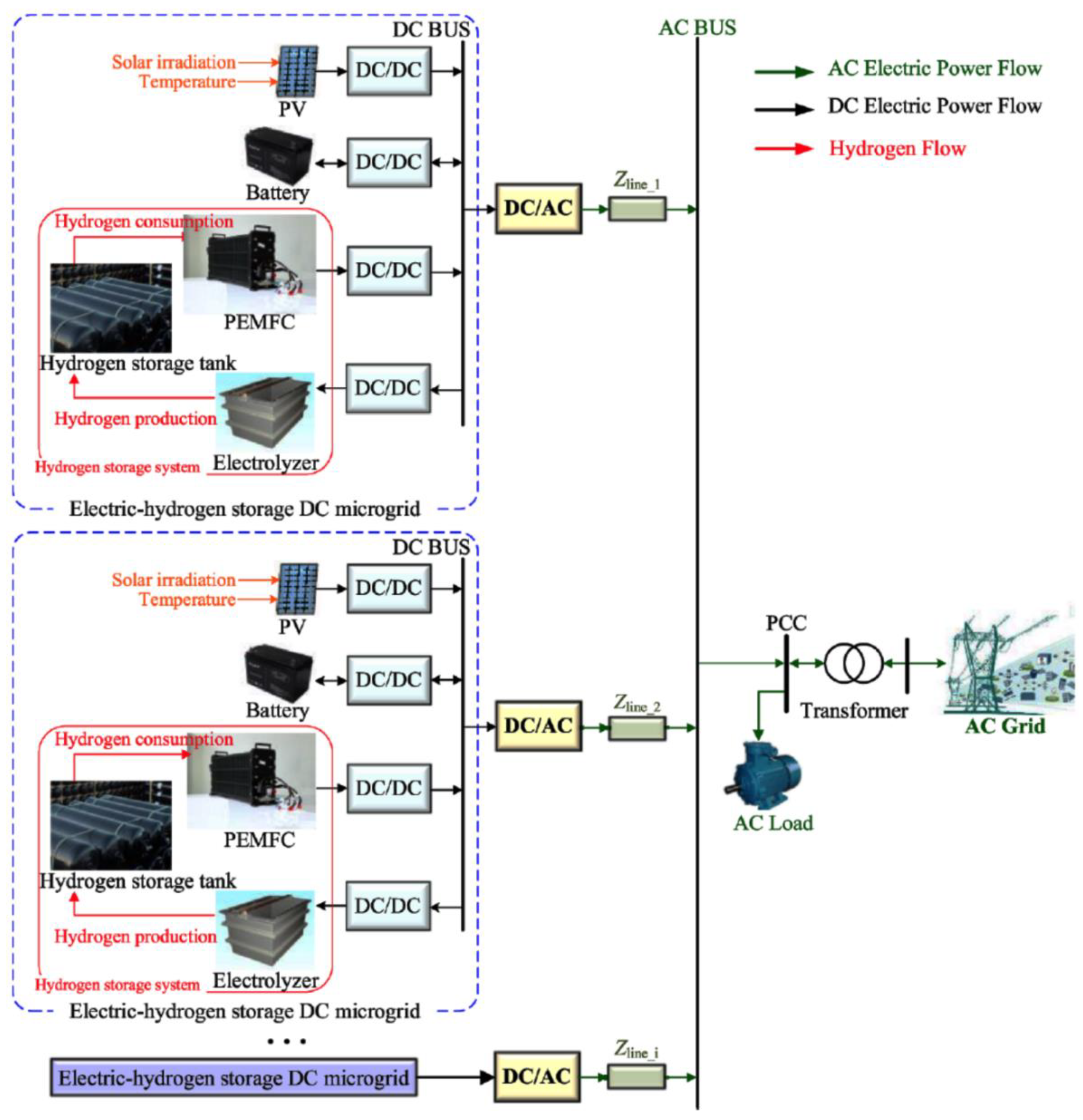


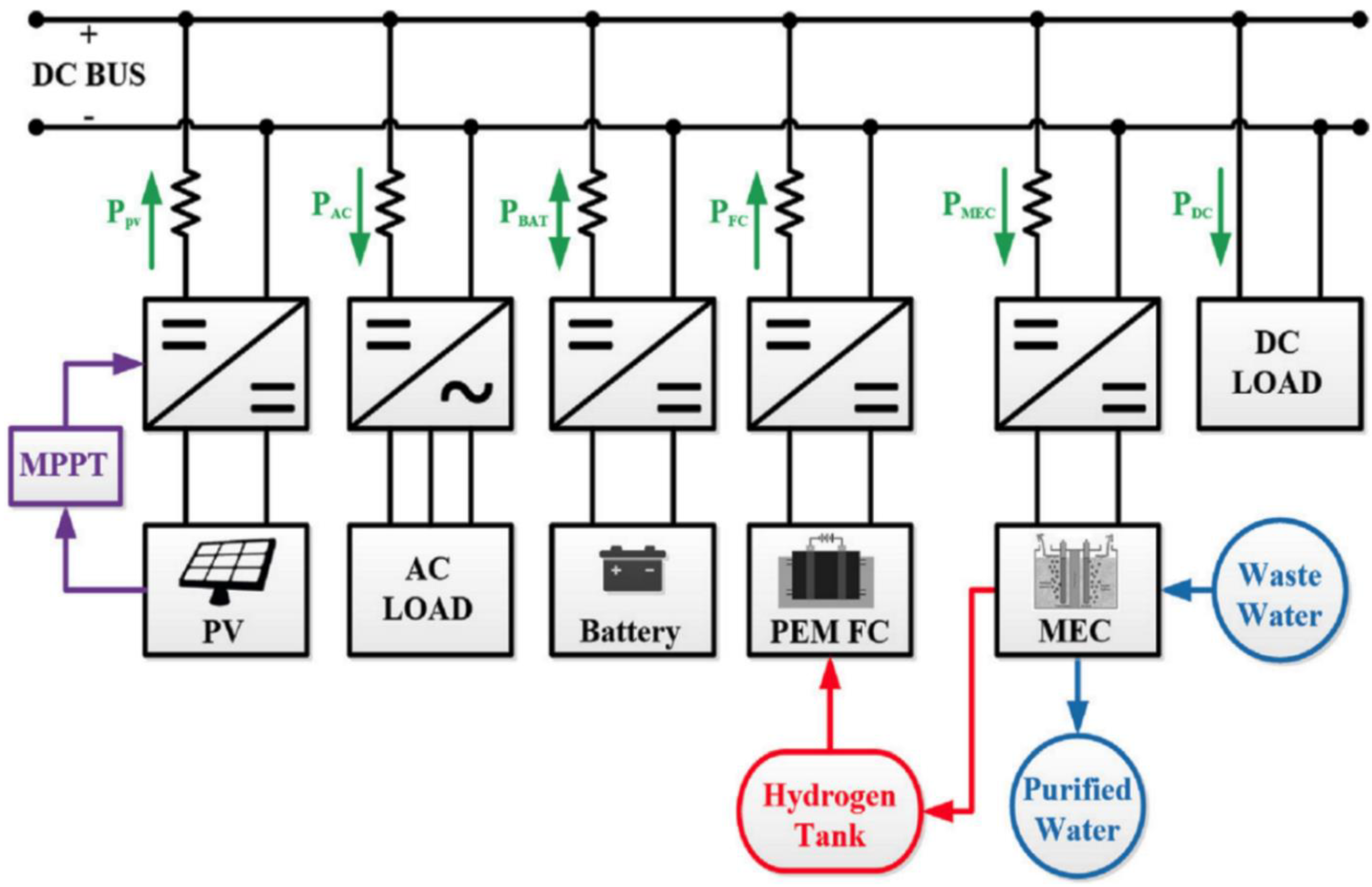
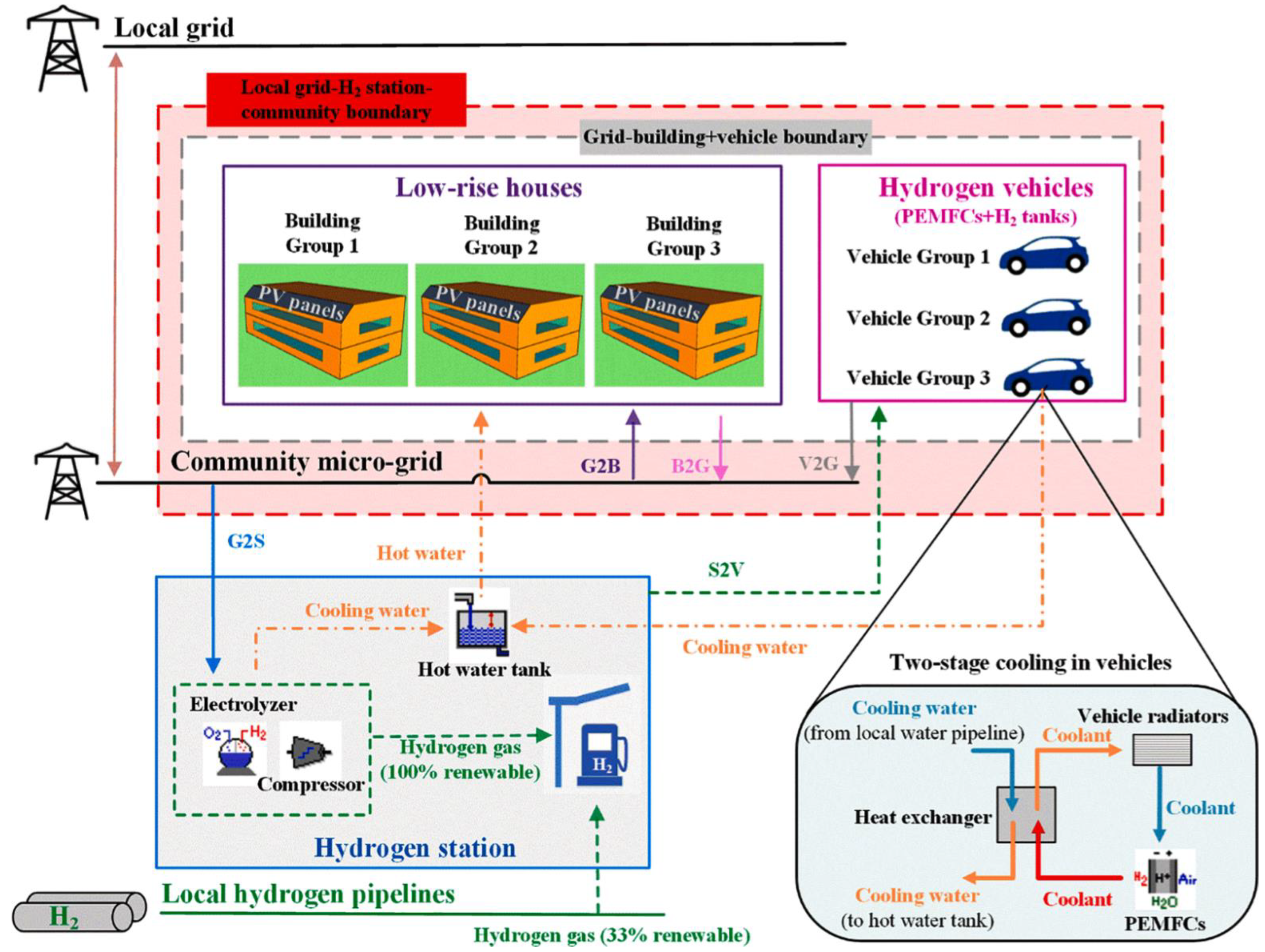

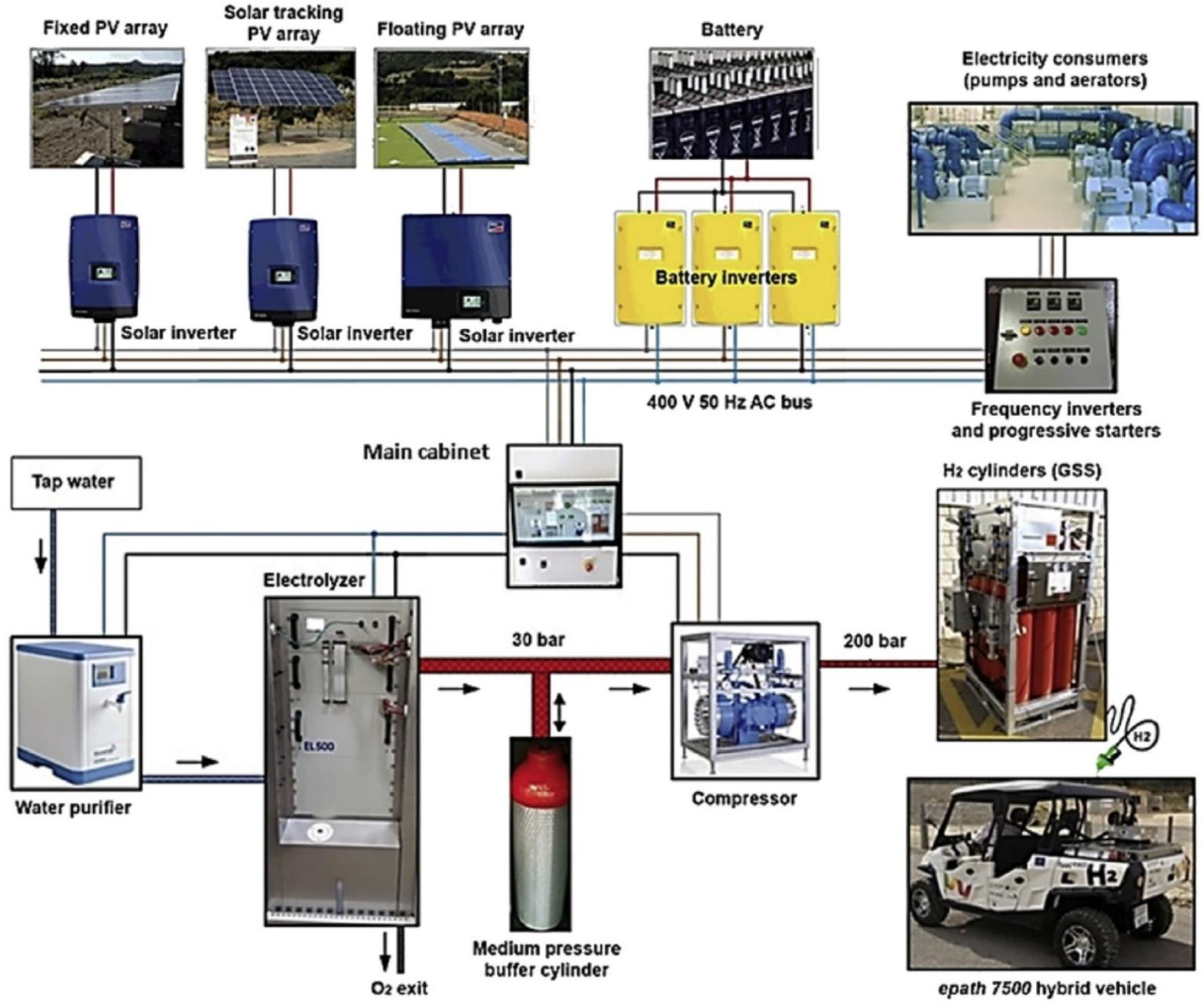

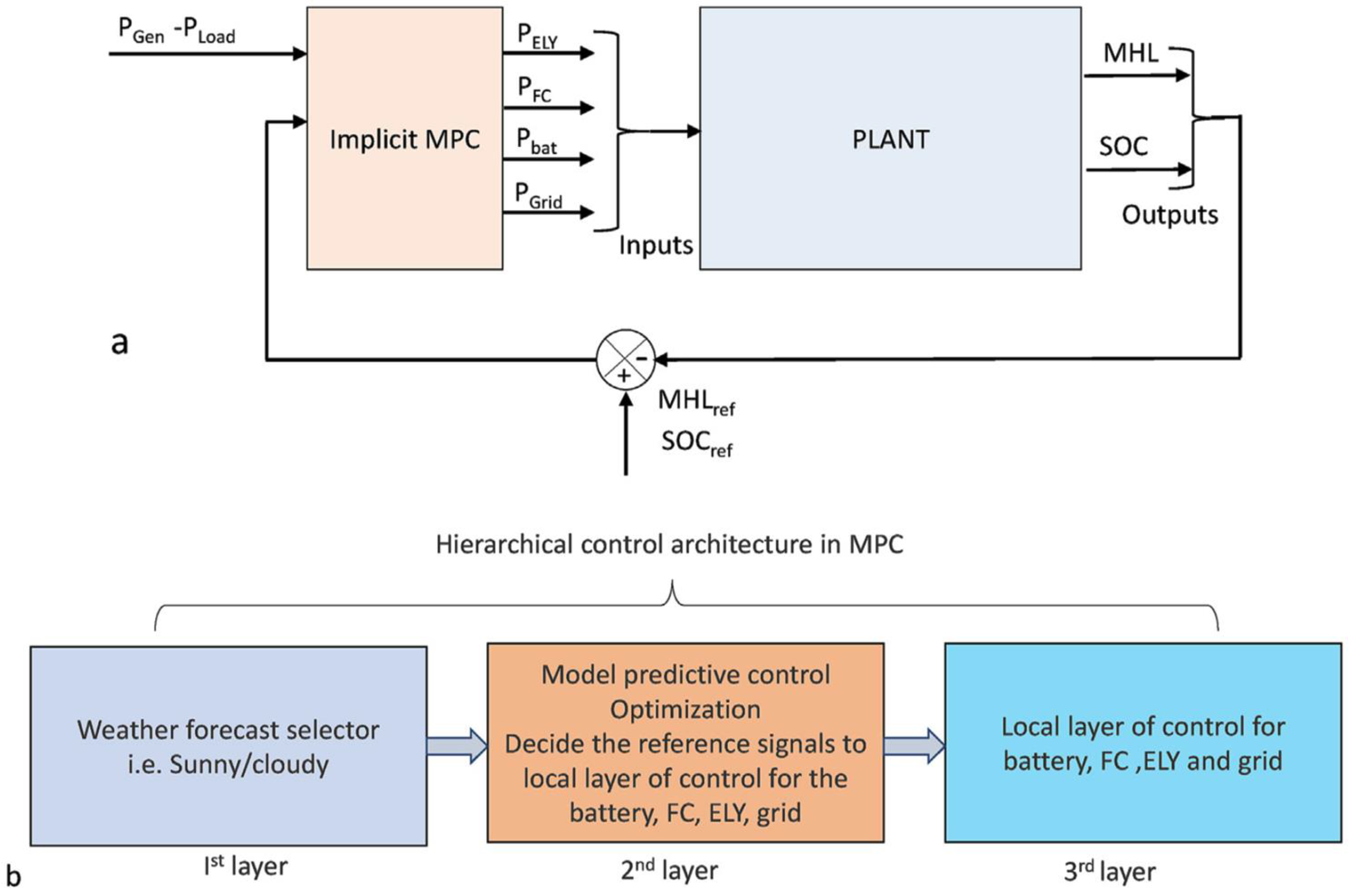

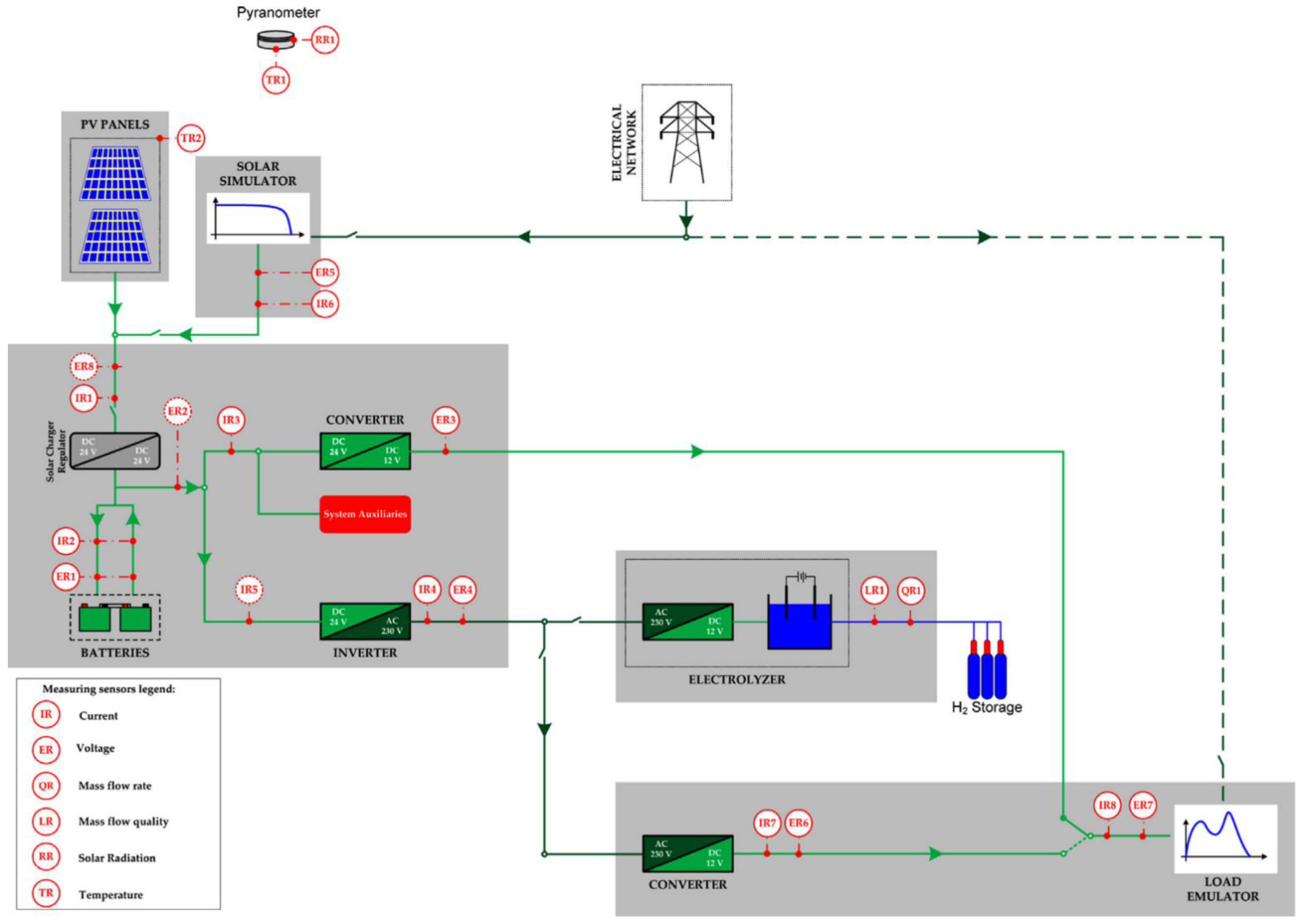
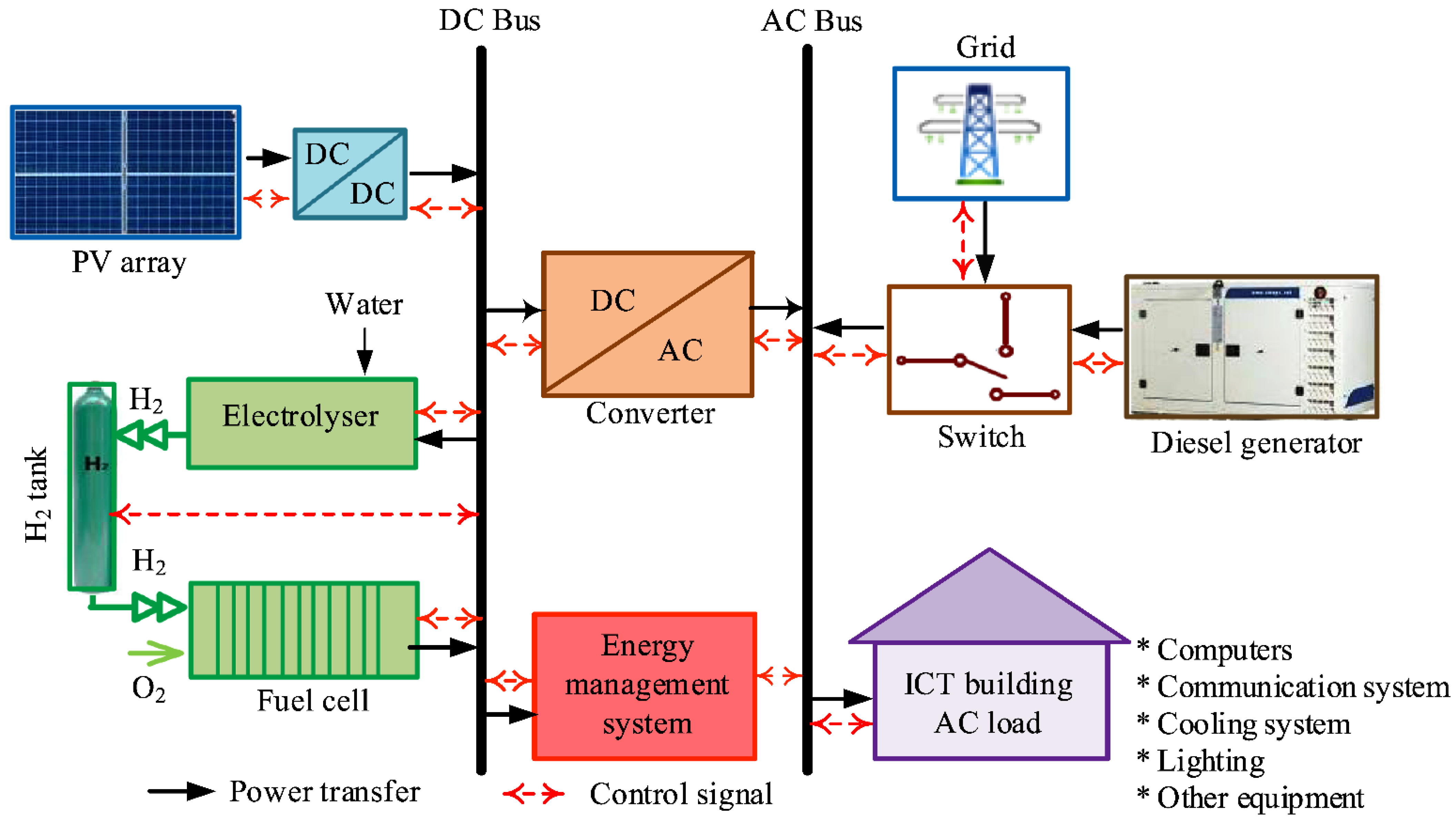
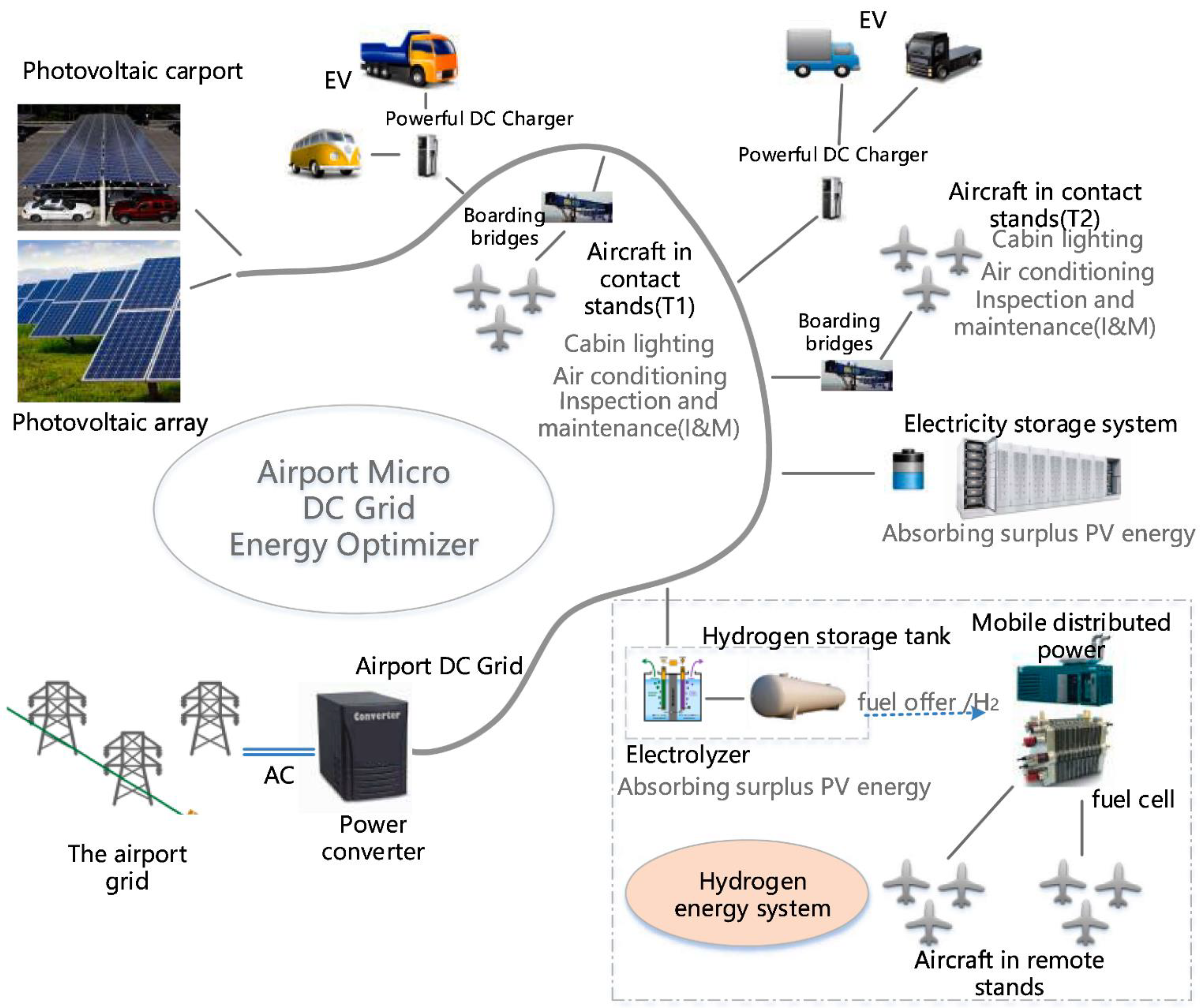
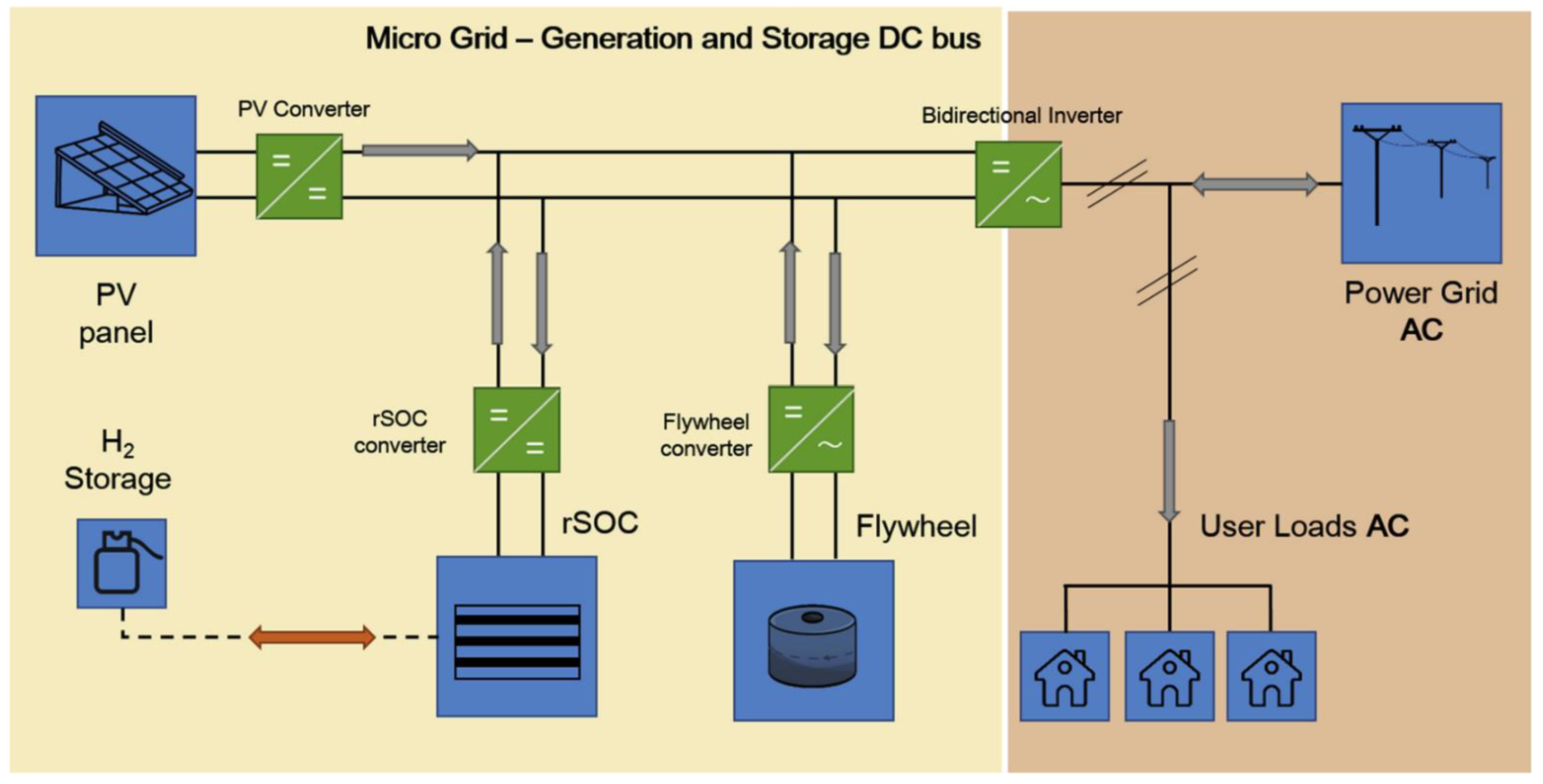
| Method | Purpose | Refs. |
|---|---|---|
| Fixed time step for transient operation (MATLAB) | Fulfilment of load profile during normal conditions by splitting demand between power generators and energy storage units | [29] |
| Mixed logical dynamical modeling (MATLAB) | Minimization of system operating cost | [26] |
| Dynamic control strategy (MATLAB) | Optimization of power management during standalone operation | [44] |
| Transient modeling (TRNSYS) | Improvement of technoeconomic performance and system flexibility | [21] |
| Optimization of component operational scheduling (MATLAB) | Minimization of environmental costs | [45] |
| Particle swarm optimization (MATLAB) | Minimization of system annual cost | [17] |
| Component/system sizing (HOMER) | Fulfillment of load requirements by considering various power generation options | [22] |
| Modeling, simulation, and sensitivity analysis (HOMER) | Minimization of the total net present cost | [46] |
| System optimization (HOMER) | Optimization of component capacities | [47] |
| System optimization (iHOGA) | Optimization of system design and performance in terms of efficiency and reliability | [41] |
| 4-phase modeling (GAMS) | Determination of the optimal design, operation, and technoeconomic assessment of the system | [25] |
| Modeling, design optimization and energy management (Odyssey) | Minimization of energy cost and maximization of the load fulfillment on an annual basis | [42] |
| Control Strategy | Purpose | Refs. |
|---|---|---|
| Greedy energy management strategy | Predictive control for a power-to-hydrogen-to-power system | [48] |
| EMS biogeography-based optimization algorithm | Control energy flow between components to optimize hydrogen generation-and-consumption | [50] |
| EMS integration | Optimization of system economic performance by relating component expected lifetime to manufacturing costs | [51] |
| EMS with reserve scheduling | Optimal operation of a 17-bus low voltage, grid-tied system to reduce the scheduled energy demand | [52] |
| EMS with quasi-proportional resonance | Distribution of power to each power generator | [53] |
| Nanogrid System | Key Result | Refs. |
|---|---|---|
| University campus | System performance highly depends on operating conditions | [7] |
| University lab | Operating costs can be reduced; HSU contribution can be maximized | [49] |
| Grid-connected lab | Self-consumption is maximized | [13] |
| University building | Reliability of power supply is improved | [54] |
| Residential | Off-grid operation is preferred because it can minimize environmental impact | [55] |
| Multipurpose System | Key Result | Refs. |
|---|---|---|
| Fueling of FCEVs for combined mobility and power generation (vehicle-to-grid) | System can reduce central grid-imported electricity by 71% | [30] |
| Winery wastewater treatment plant; vineyard pumping station for irrigation system | Fuel savings (that would have to be provided to operate a conventional diesel engine-based vehicle) | [41] |
| Cogeneration of electricity, heating, and hydrogen | System can improve performance during idling and reduce annual net hydrogen consumption from 127 to 1.2 kg per vehicle | [21] |
| Fueling station for smart city application | Provision of both electricity and hydrogen to BEVs and FCEVs is attainable | [11] |
| Fueling station for smart city application and batteries | 50% savings in terms of electricity purchase costs; battery storage can provide an additional 11% of savings | [31] |
| Battery storage for APU application for aircrafts and electric vehicles | Reduction of the total annual cost and carbon emissions by 42% and 67%, respectively | [14] |
| Grid-connected, hybrid PV-RHFC microgrid system | The energy storage subsystem can be used to trim power peaks from the central grid | [45] |
| Integrated Technologies | Key Result | Refs. |
|---|---|---|
| Wind turbines | Offsite hydrogen supply with grid-connected PV-wind-turbine power generation is the best in terms of cost (for both total net present cost and levelized cost of energy) | [46] |
| Wind turbines and FCEVs | The proposed system is not economically sustainable in terms of net present value | [25] |
| Natural gas-fueled, combined cycle power plant; electric chiller; thermal energy storage units | The dispatch strategy is activated when excess solar power is available in the microgrid | [57] |
| Electricity water nexus (wastewater treatment) | Purified water and hydrogen could be generated via microbial electrolysis cell technology; the generated hydrogen could be used to fuel a PEMFC subsystem | [44] |
| Batteries | The metal hydride HSU processes create the possibility for heat recovery from the heat release during adsorption | [47] |
| Flywheel | The proposed system can increase RES self-consumption efficiency by 11.5% | [20] |
| Anaerobic digestion with biogas; vanadium redox batteries | Components can be sized for each scenario to find the optimum solution in terms of capital and electricity costs | [22] |
| Advantages | Disadvantages |
|---|---|
| Long-term storage capability (due to RHFC) | Increased system capital cost (due to the high fuel cell and electrolyzer specific costs) |
| Increased self-consumption | Increased system complexity |
| Negligible self-discharge rates | Advanced modeling and optimization methods needed due to system nonlinearities |
| Utilization of the high energy density of hydrogen (particularly important in transport applications) | Need for sophisticated EMS control strategies |
| Multipurpose application capabilities (e.g., electricity, heating, charging BEVs, fueling FCEVs) |
Publisher’s Note: MDPI stays neutral with regard to jurisdictional claims in published maps and institutional affiliations. |
© 2022 by the authors. Licensee MDPI, Basel, Switzerland. This article is an open access article distributed under the terms and conditions of the Creative Commons Attribution (CC BY) license (https://creativecommons.org/licenses/by/4.0/).
Share and Cite
Arsalis, A.; Georghiou, G.E.; Papanastasiou, P. Recent Research Progress in Hybrid Photovoltaic–Regenerative Hydrogen Fuel Cell Microgrid Systems. Energies 2022, 15, 3512. https://doi.org/10.3390/en15103512
Arsalis A, Georghiou GE, Papanastasiou P. Recent Research Progress in Hybrid Photovoltaic–Regenerative Hydrogen Fuel Cell Microgrid Systems. Energies. 2022; 15(10):3512. https://doi.org/10.3390/en15103512
Chicago/Turabian StyleArsalis, Alexandros, George E. Georghiou, and Panos Papanastasiou. 2022. "Recent Research Progress in Hybrid Photovoltaic–Regenerative Hydrogen Fuel Cell Microgrid Systems" Energies 15, no. 10: 3512. https://doi.org/10.3390/en15103512






